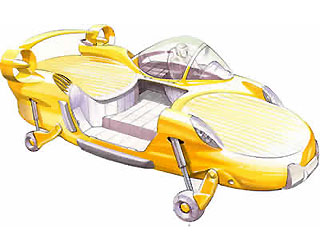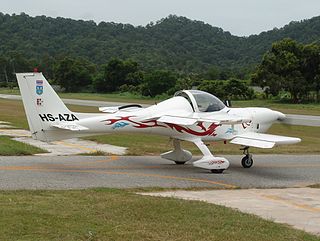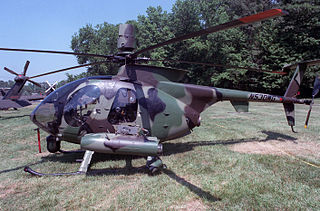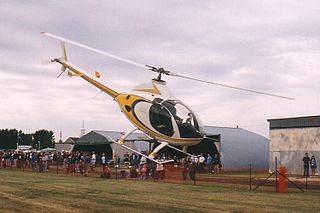
The Alliant RQ-6 Outrider unmanned aerial vehicle (UAV) was designed to provide near-real-time reconnaissance, surveillance, and target acquisition information to United States Marine Corps air/ground task forces, United States Army brigades, and deployed United States Navy units that was small enough for an entire system to be contained on two Humvees and trailer and transported on a single C-130 Hercules cargo aircraft.

Alexander Lippisch's Delta IV was a continuation of his work on delta wing designs pioneered in his Delta I, Delta II and Delta III aircraft.

The Lockheed X-7 was an American unmanned test bed of the 1950s for ramjet engines and missile guidance technology. It was the basis for the later Lockheed AQM-60 Kingfisher, a system used to test American air defenses against nuclear missile attack.

The Boeing MH-6M Little Bird and its attack variant, the AH-6, are light helicopters used for special operations in the United States Army. Originally based on a modified OH-6A, it was later based on the MD 500E, with a single five-bladed main rotor. The newest version, the MH-6M, is based on the MD 530F and has a single, six-bladed main rotor and four-bladed tail rotor.

The Boeing X-50A Dragonfly, formerly known as the Canard Rotor/Wing Demonstrator, was a VTOL rotor wing experimental unmanned aerial vehicle that was developed by Boeing and DARPA to demonstrate the principle that a helicopter's rotor could be stopped in flight and act as a fixed wing, enabling it to transition between fixed-wing and rotary-wing flight.

The Velocity XL is an American amateur-built aircraft, produced by Velocity, Inc. It is an enlarged version of their Velocity SE canard pusher design.

The Urban Aeronautics X-Hawk is a proposed flying car designed by Rafi Yoeli in Yavne, Israel, being built by Metro Skyways Ltd., a subsidiary of Yoeli's privately held company, Urban Aeronautics. The firm claims to have flown the car to a height of 90 cm (3 ft), and that greater heights are possible. The X-Hawk and its smaller unmanned version, the Tactical Robotics Cormorant, would be used in search and rescue operations where a helicopter would be useless, or at least very dangerous, such as evacuating people from the upper stories of burning buildings, or delivering and extracting police and soldiers while very close to structures, narrow streets, and confined spaces, with a projected size similar to that of a large van.

The Eagle Aircraft 150 is an Australian designed two-seat single-engine composite material training, touring and sport aircraft. It utilizes a three lifting surface design consisting of a forward wing (foreplane), main wing (mainplane) and horizontal stabilizer (tailplane). The aircraft was designed and originally built by Eagle Aircraft Pty Ltd, but is now manufactured in Malaysia by Composites Technology Research Malaysia (CTRM).
The Valmet L-80 TP Turbo-Vinha was a prototype for a new Finnish turboprop basic trainer aircraft. The aircraft, which carried the registration OH-VBB, first flew on 12 February 1985. It was destroyed in a crash on 24 April 1985, during its 14th flight, killing the test pilot Paavo Janhunen. The aircraft was a further development of the Valmet L-70 Vinka and would eventually lead to the Valmet L-90 Redigo.

The Changhe Z-11 is a light utility helicopter developed by Changhe Aircraft Industries Corporation (CAIC). According to the Changhe Aircraft Industries Corporation website, it is claimed to be the first indigenously-designed helicopter in China. However, it is largely based on the Eurocopter AS350 Écureuil.

The McDonnell Douglas Helicopter Systems MD 500 Defender is a light multi-role military helicopter based on the MD 500 light utility helicopter and OH-6 Cayuse Light Observation Helicopter.

The RotorWay Exec is a family of American two-bladed, skid-equipped, two-seat kit helicopters, manufactured by RotorWay International of Chandler, Arizona and supplied in kit form for amateur-construction.

The Sagem Crecerelle ("Kestrel") is a reconnaissance UAV developed in France in the 1990s, based on the Meggitt Banshee target drone. Its configuration is much like that of the Banshee, with a pusher prop, a clipped delta wing, and a single tailfin, though its fuselage is more cylindrical. It is powered by a 20 kW (26 hp) rotary engine and has no landing gear, being recovered by parachute and airbags. The Crecerelle saw action with French forces during the Kosovo campaign in 1999. Meggitt sells much the same machine as the Spectre.
The XMQ-17A ("SpyHawk") is an unmanned aerial vehicle built and developed by MTC Technologies which was intended to be used by the US Marine Corps in order to fulfill a need for an unmanned aerial reconnaissance capability at division level, or "Tier II". Launched from a trailer-mounted pneumatic launcher, the aircraft is powered by a single Honda GX-57 gasoline-fueled piston engine. The SpyHawk purchase was canceled in January 2008, after MTC Technologies was purchased by BAE Systems.

HESA Shahed 285 is a light attack/reconnaissance helicopter developed in Iran. It was unveiled on 24 May 2009. It is being produced in two versions: a light attack/recon version and a maritime patrol/anti-ship version.

The BPL Pegaz 011 is a tactical unmanned aerial vehicle prototype developed at the Military Engineering Institute, premiered at the 2011 Partner Arms Fair.
The Vortech G-1, also called the Compcop G-1, is an American helicopter that was designed in the 1970s. Plans for amateur construction were originally supplied by Compcop and today are provided by Vortech.
TAI Keklik is a radio-controlled tracking target drone introduced in 2001. Designed, developed and built by Turkish Aerospace Industries (TAI), the unmanned aerial vehicle (UAV) is in use by the Turkish Armed Forces for target tracking in non-firing gunnery exercises.

WB Electronics Warmate is a class of loitering munition UAVs developed by the Polish defence contractor WB Group. It can be equipped with several different payloads, including fragmentation, HEAT and thermobaric warheads and has a swarming capability.
The Meggitt Vindicator II is a Canadian-built unmanned aerial vehicle – training target formerly used by the Canadian Forces and United States Navy. It was used to simulate various types of targets like missiles and aircraft, including helicopters. The vehicle was not powered, but was launched via pneumatic catapult.















